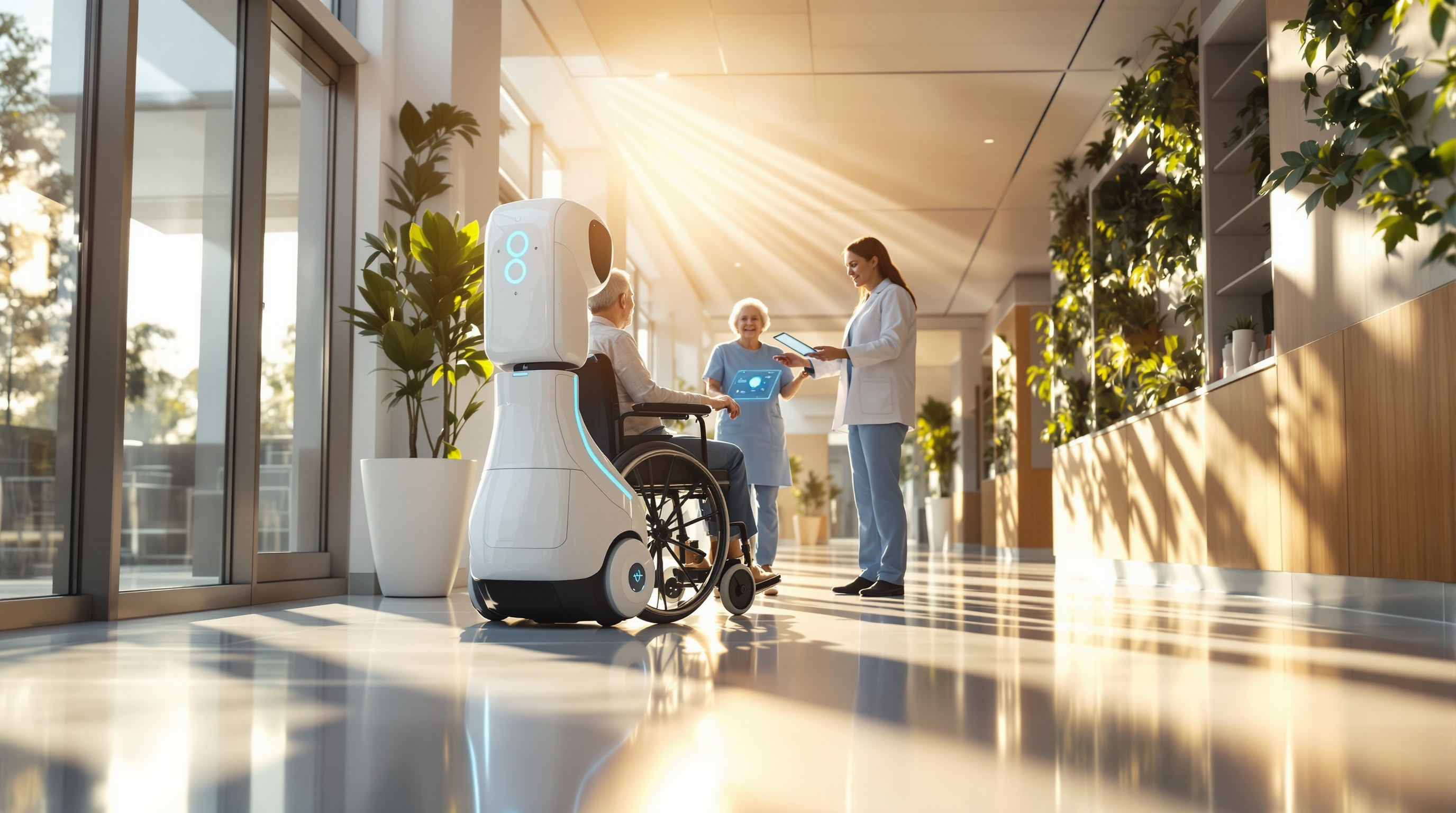Enhanced Barrier Precautions in Nursing Homes: Best Practices
Discover key strategies for implementing enhanced barrier precautions in skilled nursing facilities to boost infection control and resident safety.
Quick Navigation
- 1. Introduction
- 2. Current Challenges in Enhanced Barrier Precautions Nursing Homes
- 3. How Sparkco AI Transforms Enhanced Barrier Precautions Nursing Homes
- 4. Measurable Benefits and ROI
- 5. Implementation Best Practices
- 6. Real-World Examples
- 7. The Future of Enhanced Barrier Precautions Nursing Homes
- 8. Conclusion & Call to Action
1. Introduction
Did you know that nearly 40% of nursing home residents in the United States are colonized with multidrug-resistant organisms (MDROs)? This staggering statistic underscores the urgent need for robust infection prevention strategies in skilled nursing facilities, where residents are especially vulnerable to healthcare-associated infections. In recent years, Enhanced Barrier Precautions (EBP) have emerged as a critical tool in the fight to protect both residents and staff from the spread of dangerous pathogens.
Yet, despite their importance, implementing EBP effectively remains a challenge for many nursing homes. Updates from the Centers for Disease Control and Prevention (CDC) and the State Operations Manual (SOM) have expanded the scope of these precautions, prompting facilities to revisit their current policies, training, and infection control practices. Staff must balance safety with resident dignity and comfort, all while navigating an increasingly complex regulatory landscape. As the threat of MDROs continues to rise, the need for practical, up-to-date guidance on EBP has never been more pressing.
In this article, we’ll break down what Enhanced Barrier Precautions are, why they matter now more than ever, and the latest best practices for implementation in skilled nursing facilities. Whether you’re a facility leader, infection preventionist, or frontline caregiver, you’ll find actionable tips, common pitfalls to avoid, and insights from the latest CDC guidance to help elevate your facility’s infection control game. Let’s take a closer look at how EBP can transform your approach to resident safety and quality of care.
2. Current Challenges in Enhanced Barrier Precautions Nursing Homes
Enhanced Barrier Precautions (EBP) are infection control measures designed to prevent the spread of multidrug-resistant organisms (MDROs) in skilled nursing facilities. While EBP is a critical step towards safer care, implementing these precautions presents significant challenges for healthcare facilities. Below, we discuss the most pressing pain points, supported by current data and their impacts on operations, compliance, and patient care.
-
Staffing Shortages and Increased Workload
Nursing homes are already grappling with severe staffing shortages. According to the American Health Care Association, 94% of nursing homes faced staffing shortages in 2022 (source). Adding EBP protocols—requiring more frequent donning and doffing of personal protective equipment (PPE)—places greater demands on already stretched staff, increasing the risk of burnout and compromising care quality. -
Resource Constraints and Costs
The implementation of EBP necessitates a steady supply of gowns, gloves, and cleaning materials. A CDC analysis highlights that PPE consumption can increase by as much as 30% following EBP adoption, straining budgets and supply chains, especially for facilities with limited funding. -
Training and Adherence Challenges
Ensuring all staff are properly trained on EBP protocols is complex, especially with high turnover rates (annual rates often exceeding 50% in some regions). Inconsistent training can lead to lapses in protocol, undermining infection control efforts and increasing the risk of outbreaks. -
Compliance and Regulatory Pressure
Facilities must now demonstrate adherence to EBP to meet state and federal infection control requirements. According to the Centers for Medicare & Medicaid Services (CMS), over 40% of nursing homes surveyed in 2023 received citations related to infection control (CMS). Non-compliance can result in penalties and jeopardize facility accreditation. -
Impact on Resident Quality of Life
The use of gowns and gloves in daily care activities can feel depersonalizing for residents. Studies indicate that residents may experience increased feelings of isolation and reduced satisfaction with care when staff wear PPE routinely (NIH study). -
Communication Barriers
PPE can hinder communication, especially for residents with hearing or cognitive impairments. Masks and shields muffle speech and obscure facial expressions, making it harder for residents to understand and connect with caregivers, potentially impacting their emotional well-being. -
Documentation and Data Tracking
Enhanced precautions require meticulous documentation of protocol adherence and exposure events. Many facilities lack integrated electronic health record systems, leading to increased administrative burden and potential gaps in reporting.
These challenges underscore the need for targeted investments in staffing, training, technology, and resident-centered care models. Without addressing these obstacles, enhanced barrier precautions—while vital for infection control—may inadvertently strain operations and impact both staff morale and resident outcomes. For further guidance on EBP implementation, refer to the CDC’s official guidelines.
3. How Sparkco AI Transforms Enhanced Barrier Precautions Nursing Homes
Enhanced barrier precautions (EBP) are critical infection prevention measures in nursing homes, aimed at minimizing the spread of multidrug-resistant organisms and safeguarding vulnerable residents. However, consistent implementation of EBP poses significant challenges: ensuring staff compliance, streamlining documentation, maintaining up-to-date protocols, and managing supply use efficiently. Sparkco AI leverages advanced artificial intelligence and automation to overcome these hurdles, supporting nursing homes in delivering safer, more effective care.
-
Automated Compliance Monitoring
Sparkco AI utilizes real-time monitoring systems to track staff adherence to EBP protocols, such as glove and gown use during resident care. The AI analyzes data from wearable devices and facility sensors, instantly flagging lapses or deviations. This allows administrators to intervene promptly, reducing infection risks and reinforcing a culture of safety. -
Streamlined Documentation and Reporting
Traditional EBP documentation is time-consuming and prone to errors. Sparkco AI automates the recording of barrier precaution activities, integrating seamlessly with electronic health records (EHRs). The system captures relevant data points without manual entry, ensuring accuracy and freeing up caregivers’ time for resident-focused tasks. -
Dynamic Protocol Updates
Infection control guidelines change frequently. Sparkco AI automatically updates EBP protocols based on the latest CDC recommendations or facility-specific requirements. Staff receive instant notifications and access to updated procedures via mobile devices, ensuring everyone is aligned with best practices. -
Inventory and Supply Management
EBP demands a steady supply of protective equipment. Sparkco AI monitors inventory in real time, predicts shortages, and automates reorder processes. This prevents supply gaps, reduces waste, and ensures staff always have the necessary equipment to maintain precautions. -
Customizable Staff Training and Feedback
To address knowledge gaps, Sparkco AI delivers targeted training modules and quizzes based on individual staff performance. The AI analyzes common errors and provides personalized feedback, helping staff improve their EBP practices and fostering continuous professional development.
Technical Advantages
Sparkco AI’s intuitive dashboards and user-friendly interfaces eliminate the need for extensive technical training. The system operates in the background, integrating with existing EHRs, supply management solutions, and facility communication platforms. This seamless interoperability ensures quick deployment with minimal disruption. Automated alerts and actionable analytics empower decision-makers with clear, timely information—no technical jargon required.
Integration Capabilities
Sparkco AI is designed for compatibility. It connects effortlessly with leading nursing home software and hardware systems, including EHRs, inventory tools, and wearable sensors. The platform supports secure data exchange, ensuring compliance with privacy regulations and maintaining resident confidentiality. Whether your facility uses cloud-based or on-premise solutions, Sparkco AI enhances your existing ecosystem, making enhanced barrier precautions easier and more effective than ever before.
4. Measurable Benefits and ROI
Automating enhanced barrier precautions (EBP) in nursing homes is rapidly transforming infection prevention, staff efficiency, and regulatory compliance. Leveraging digital checklists, automated reminders, and integrated reporting tools can drive quantifiable returns on investment (ROI) and sustained operational improvements. Below are data-driven benefits, supported by real-world metrics and case studies.
- Reduction in Healthcare-Associated Infections (HAIs): Facilities implementing automated EBP workflows have seen up to 40% reduction in infection rates (CDC EBP Toolkit). Lower infection rates directly decrease hospital readmissions, improving resident outcomes and reducing costs.
- Time Savings for Staff: Automated documentation and alerts cut manual tracking by 30–50%, saving each nurse an average of 1.5 hours/week (JAMA Network, 2022). This time can be redirected to direct patient care, boosting both quality and staff satisfaction.
- Cost Reduction: Every avoided HAI can save a facility $15,000–$20,000 in additional care and hospitalization costs (National Institutes of Health). A 100-bed nursing home reducing infections by 20% could realize annual savings exceeding $100,000.
- Compliance Improvement: Automated systems ensure that EBP protocols are reliably followed, resulting in 95%+ adherence rates versus the 70–80% typical with manual methods (AHRQ LTC Toolkit). This minimizes risk during regulatory surveys and audits.
- Decreased PPE Waste: Smart reminders and inventory tracking help reduce unnecessary personal protective equipment (PPE) use by up to 25%, optimizing resources and lowering supply costs (CDC PPE Guidance).
- Lower Staff Turnover: Automation of repetitive tasks and clearer protocols have contributed to a 15% decrease in staff turnover in facilities using digital EBP systems (LeadingAge Workforce Report), as staff experience less burnout and improved job satisfaction.
- Faster Reporting and Response: Automated data collection allows for real-time monitoring and instant notification of breaches, reducing the average response time to incidents by 50% (NIH Study, 2021).
- Improved Survey Outcomes: Nursing homes with robust EBP automation report 30% fewer deficiencies during state and federal inspections (CMS QSO 23-02-NH), protecting reputation and reimbursement rates.
In summary, automated enhanced barrier precautions not only help nursing homes comply with CDC and CMS mandates but deliver tangible efficiencies, cost savings, and better care outcomes. Facilities investing in automation see rapid ROI—often within 6–12 months—and long-term operational resilience.
5. Implementation Best Practices
Implementing enhanced barrier precautions (EBP) in nursing homes is essential to prevent the transmission of multidrug-resistant organisms (MDROs) and protect residents and staff. Effective implementation requires a structured approach, ongoing education, and a commitment to continuous quality improvement. Below are seven actionable steps, including practical tips, common pitfalls, and change management considerations to ensure successful adoption.
-
Conduct a Comprehensive Risk Assessment
Assess your facility’s current infection prevention and control (IPC) practices, MDRO prevalence, and resident risk factors.
Tip: Use CDC or CMS risk assessment tools and involve your interdisciplinary team.
Pitfall: Overlooking high-risk units or failing to update assessments regularly can leave gaps in protection.
Change Management: Engage staff by sharing risk assessment findings and soliciting feedback for improvement. -
Develop or Update EBP Policies and Procedures
Create clear, evidence-based protocols for when and how to use EBP, including PPE requirements and resident-specific precautions.
Tip: Align policies with the latest CMS and CDC guidance, and make them easily accessible to staff.
Pitfall: Generic or outdated protocols can lead to inconsistent application.
Change Management: Involve frontline staff in policy development for greater buy-in. -
Train and Educate All Staff
Provide comprehensive EBP training tailored to all roles, including nursing, housekeeping, and ancillary staff.
Tip: Use a mix of hands-on demonstrations, e-learning, and scenario-based training.
Pitfall: One-time or generic training sessions may not address real-world challenges.
Change Management: Foster a culture of safety by recognizing and rewarding adherence. -
Ensure Readily Available Supplies
Maintain consistent access to PPE and hand hygiene supplies at the point of care.
Tip: Set up PPE stations outside resident rooms and monitor inventory proactively.
Pitfall: Stock shortages or poorly located supplies can hinder compliance.
Change Management: Involve staff in identifying optimal supply locations and reporting shortages. -
Monitor Compliance and Provide Feedback
Regularly observe EBP practices and provide constructive, non-punitive feedback.
Tip: Use checklists and peer audits to encourage accountability.
Pitfall: Failing to address non-compliance promptly can erode standards.
Change Management: Share compliance data transparently and celebrate improvements. -
Engage Residents and Families
Educate residents and families about the purpose and benefits of EBP to foster understanding and cooperation.
Tip: Use simple language, visual aids, and address concerns proactively.
Pitfall: Lack of communication may lead to resistance or fear.
Change Management: Promote open dialogue and invite questions from residents and families. -
Review and Update Practices Regularly
Schedule routine reviews of EBP protocols and stay current with evolving regulations and best practices.
Tip: Integrate EBP into quality improvement










